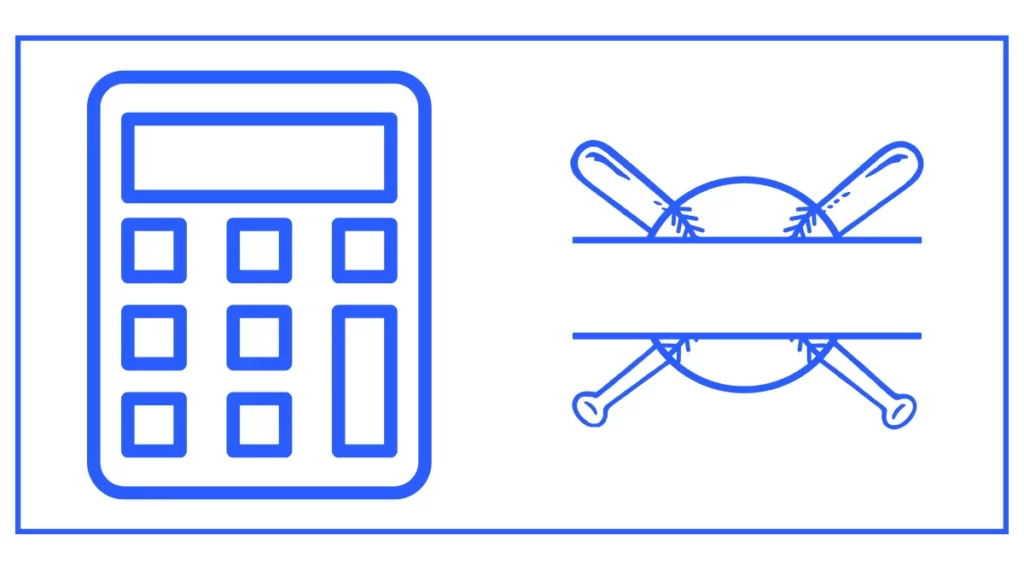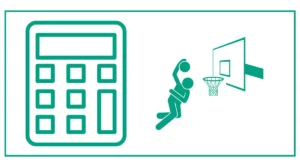Slugging Percentage Calculator
Are you looking for an easy way to calculate your slugging percentage?
In case you don’t know what slugging percentage means in baseball.
A player’s slugging percentage is the number of bases he or she gets per at-bat. Unlike on-base percentage, slugging percentage only looks at hits. Walks and being hit by a pitch are not part of the equation. The difference between slugging percentage and batting average is that not all hits are worth the same.
The slugging percentage calculator helps you calculate your baseball slugging percentage easily just like effective field percentage..
Simply enter the no. of singles, doubles, triples, home runs, and at bats to find out the slugging percentage.

You might be interested in discovering your Earned Runs Average.
What is Slugging Percentage?
Slugging percentage is a baseball statistic that represents the total number of bases a player achieves per at-bat. It’s a more nuanced measure of a player’s batting prowess than batting average alone, as it takes into account the quality of hits rather than just their frequency.
Slugging percentage gives a clearer picture of a batter’s power and overall offensive contribution. While batting average treats all hits equally, slugging percentage assigns more value to extra-base hits, providing a more comprehensive view of a player’s ability to generate runs.
How to Calculate Slugging Percentage?
The formula for calculating slugging percentage is straightforward:
SLG = (1B + 2 × 2B + 3 × 3B + 4 × HR) / AB
Where:
- 1B = Number of singles
- 2B = Number of doubles
- 3B = Number of triples
- HR = Number of home runs
- AB = Number of at-bats
Step-by-Step Calculation
- Count the number of singles, doubles, triples, and home runs a player has hit.
- Multiply the number of doubles by 2, triples by 3, and home runs by 4.
- Add these values to the number of singles to get the total bases.
- Divide the total bases by the number of at-bats.
- The result, typically expressed as a decimal to three places, is the slugging percentage.
Using a Slugging Percentage Calculator
To simplify the process, many baseball enthusiasts and professionals use a slugging percentage calculator. These tools streamline the computation, allowing for quick and accurate results.
Benefits of Using a Slugging Percentage Calculator
- Accuracy: Eliminates human error in calculations.
- Efficiency: Saves time, especially when calculating for multiple players or seasons.
- Consistency: Ensures uniform results across different users.
How to Use a Slugging Percentage Calculator
Most slugging percentage calculators follow these basic steps:
- Input the number of singles, doubles, triples, and home runs.
- Enter the total number of at-bats.
- Click “Calculate” or a similar button.
- The calculator will display the slugging percentage, typically rounded to three decimal places.
Interpreting Slugging Percentage
Understanding what constitutes a good slugging percentage is crucial for evaluating player performance.
Slugging Percentage Scale
- .300 or lower: Poor
- .350: Below average
- .400: Average
- .450: Above average
- .500: Excellent
- .600+: Outstanding
It’s important to note that these benchmarks can vary depending on the era, league, and position of the player.
Slugging Percentage vs. Other Baseball Statistics
While slugging percentage is a valuable metric, it’s often used in conjunction with other statistics for a more comprehensive evaluation of a player’s offensive capabilities.
Slugging Percentage and Batting Average
Batting average measures how often a player gets a hit, while slugging percentage measures the quality of those hits. A player with a high batting average but low slugging percentage might be good at getting on base with singles, but lacks power hitting ability.
On-Base Plus Slugging (OPS)
OPS combines on-base percentage and slugging percentage to provide a more complete picture of a player’s offensive value. It’s calculated by adding a player’s on-base percentage to their slugging percentage.
Historical Context of Slugging Percentage
Slugging percentage has been a part of baseball statistics since the early 20th century, but its importance has grown with the advancement of statistical analysis in the sport.
Notable Slugging Percentages in MLB History
- Babe Ruth holds the career slugging percentage record at .6897.
- Barry Bonds has the single-season record with .863 in 2001.
These exceptional figures highlight the rarity of sustaining a high slugging percentage over an extended period.
Factors Affecting Slugging Percentage
Several factors can influence a player’s slugging percentage:
- Ballpark dimensions: Smaller parks may inflate slugging percentages due to easier home runs.
- Pitching quality: Facing tougher pitchers can lower slugging percentages.
- Player’s role: Leadoff hitters might focus more on getting on base rather than hitting for power.
- Weather conditions: Wind and temperature can affect how far the ball travels.
Slugging Percentage in Player Evaluation
Teams and scouts use slugging percentage as one of many tools to evaluate players. It’s particularly useful for:
- Comparing power hitters
- Assessing a player’s overall offensive contribution
- Identifying potential for improvement in young players
However, it’s crucial to consider slugging percentage alongside other metrics and contextual factors for a comprehensive evaluation.
Limitations of Slugging Percentage
While valuable, slugging percentage has some limitations:
- It doesn’t account for walks or hit-by-pitches.
- It treats all extra-base hits equally within their category (e.g., a 450-foot home run counts the same as a 330-foot home run).
- It doesn’t consider the game situation or the impact of the hit on the game outcome.






